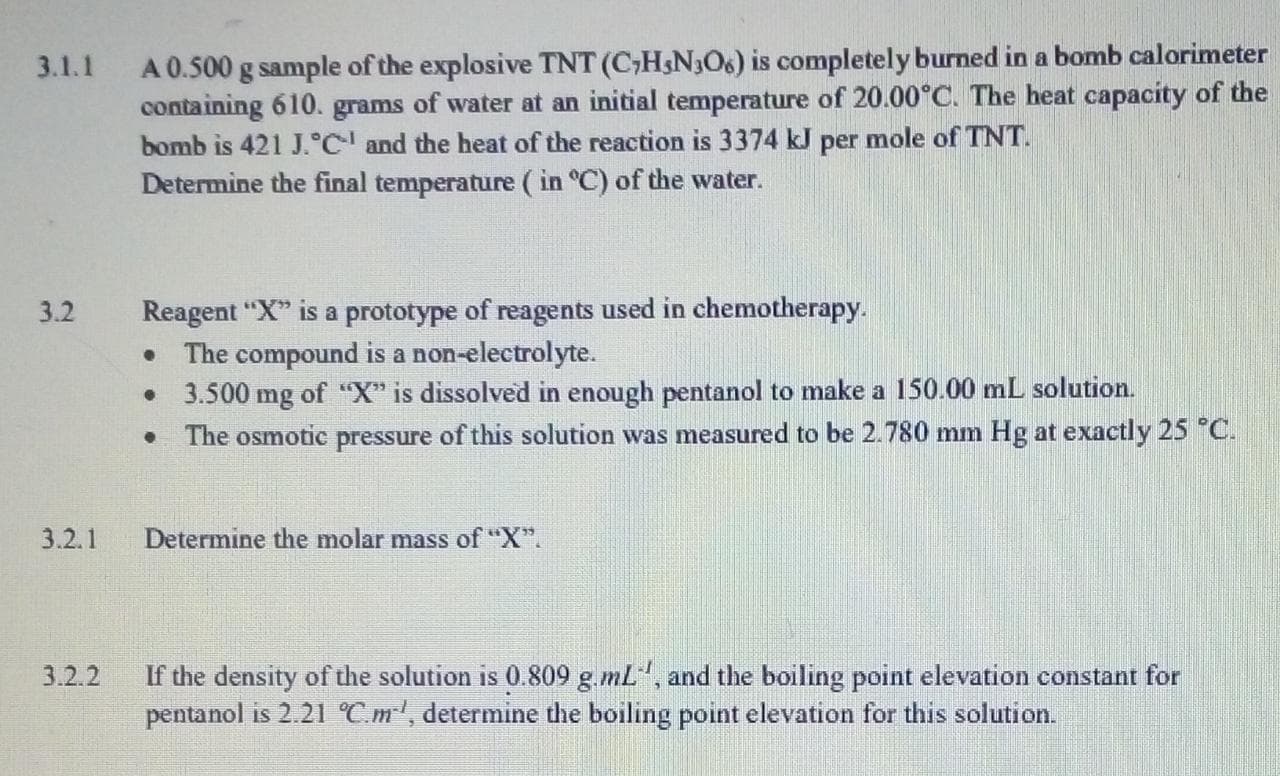A 0.500 g sample of the explosive TNT (C,H&N3O6) is completely burned in a bomb calorimeter containing 610. grams of water at an initial temperature of 20.00°C. The heat capacity of the bomb is 421 J.C' and the heat of the reaction is 3374 kJ per mole of TNT. Determine the final temperature ( in °C) of the water. 3.1.1 Reagent "X" is a prototype of reagents used in chemotherapy. The compound is a non-electrolyte. • 3.500 mg of "X" is dissolved in enough pentanol to make a 150.00 mL solution. • The osmotic pressure of this solution was measured to be 2.780 mm Hg at exactly 25 °C. 3.2 3.2.1 Determine the molar mass of "X".
A 0.500 g sample of the explosive TNT (C,H&N3O6) is completely burned in a bomb calorimeter containing 610. grams of water at an initial temperature of 20.00°C. The heat capacity of the bomb is 421 J.C' and the heat of the reaction is 3374 kJ per mole of TNT. Determine the final temperature ( in °C) of the water. 3.1.1 Reagent "X" is a prototype of reagents used in chemotherapy. The compound is a non-electrolyte. • 3.500 mg of "X" is dissolved in enough pentanol to make a 150.00 mL solution. • The osmotic pressure of this solution was measured to be 2.780 mm Hg at exactly 25 °C. 3.2 3.2.1 Determine the molar mass of "X".
Chemistry: An Atoms First Approach
2nd Edition
ISBN:9781305079243
Author:Steven S. Zumdahl, Susan A. Zumdahl
Publisher:Steven S. Zumdahl, Susan A. Zumdahl
Chapter7: Chemical Energy
Section: Chapter Questions
Problem 59E: In a coffee-cup calorimeter, 50.0 mL of 0.100 M AgNO3 and 50.0 mL of 0.100 M HCl are mixed to yield...
Related questions
Question

Transcribed Image Text:A 0.500 g sample of the explosive TNT (C,H&N3O6) is completely burned in a bomb calorimeter
containing 610. grams of water at an initial temperature of 20.00°C. The heat capacity of the
bomb is 421 J.C' and the heat of the reaction is 3374 kJ per mole of TNT.
Determine the final temperature ( in °C) of the water.
3.1.1
Reagent "X" is a prototype of reagents used in chemotherapy.
The compound is a non-electrolyte.
• 3.500 mg of "X" is dissolved in enough pentanol to make a 150.00 mL solution.
• The osmotic pressure of this solution was measured to be 2.780 mm Hg at exactly 25 °C.
3.2
3.2.1
Determine the molar mass of "X".
Expert Solution
This question has been solved!
Explore an expertly crafted, step-by-step solution for a thorough understanding of key concepts.
This is a popular solution!
Trending now
This is a popular solution!
Step by step
Solved in 4 steps with 4 images

Knowledge Booster
Learn more about
Need a deep-dive on the concept behind this application? Look no further. Learn more about this topic, chemistry and related others by exploring similar questions and additional content below.Recommended textbooks for you

Chemistry: An Atoms First Approach
Chemistry
ISBN:
9781305079243
Author:
Steven S. Zumdahl, Susan A. Zumdahl
Publisher:
Cengage Learning

Chemistry & Chemical Reactivity
Chemistry
ISBN:
9781337399074
Author:
John C. Kotz, Paul M. Treichel, John Townsend, David Treichel
Publisher:
Cengage Learning

Chemistry & Chemical Reactivity
Chemistry
ISBN:
9781133949640
Author:
John C. Kotz, Paul M. Treichel, John Townsend, David Treichel
Publisher:
Cengage Learning

Chemistry: An Atoms First Approach
Chemistry
ISBN:
9781305079243
Author:
Steven S. Zumdahl, Susan A. Zumdahl
Publisher:
Cengage Learning

Chemistry & Chemical Reactivity
Chemistry
ISBN:
9781337399074
Author:
John C. Kotz, Paul M. Treichel, John Townsend, David Treichel
Publisher:
Cengage Learning

Chemistry & Chemical Reactivity
Chemistry
ISBN:
9781133949640
Author:
John C. Kotz, Paul M. Treichel, John Townsend, David Treichel
Publisher:
Cengage Learning

Chemistry: Principles and Reactions
Chemistry
ISBN:
9781305079373
Author:
William L. Masterton, Cecile N. Hurley
Publisher:
Cengage Learning

Chemistry by OpenStax (2015-05-04)
Chemistry
ISBN:
9781938168390
Author:
Klaus Theopold, Richard H Langley, Paul Flowers, William R. Robinson, Mark Blaser
Publisher:
OpenStax

Chemistry
Chemistry
ISBN:
9781305957404
Author:
Steven S. Zumdahl, Susan A. Zumdahl, Donald J. DeCoste
Publisher:
Cengage Learning